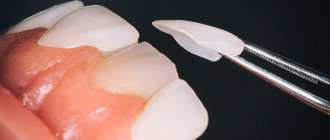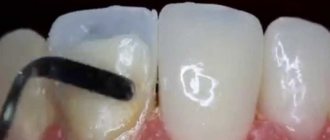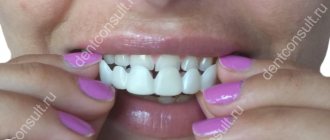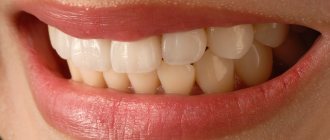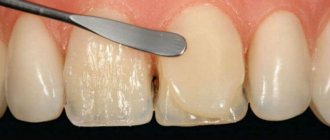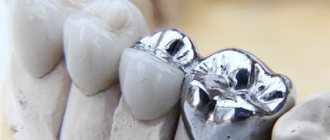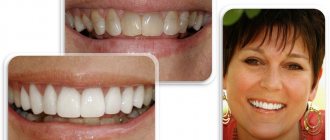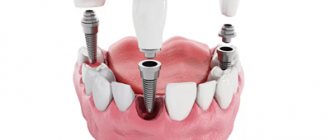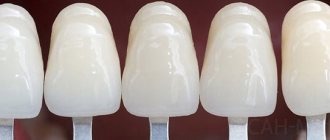To understand which veneers to choose, ceramic or composite, let’s take a closer look at what dental veneers are and what their features are. Veneers are thin plates of ceramic (sometimes zirconium) or composite material that are fixed to the front side of the teeth. Such microprostheses are used to correct aesthetic defects of the dentofacial apparatus and provide additional protection to the enamel. The onlays, made from impressions, imitate the natural shade of the dentition and do not stand out from it.
Veneering straightens the dentition, hides defects (uneven teeth, large interdental gaps, cracks or chips of the coronal shell), simplifies oral hygiene, and serves as an effective means of preventing periodontal diseases.
Author of the article: Meliksetyan Daniel Oganesovich
Work experience:
15 years
Specialization:
Dentist-orthopedist
Works:
at the clinic on Proletarskaya metro station
Types of veneers
Microprostheses are divided into composite and porcelain. Composite ones are divided into:
- Direct
Made in the patient's mouth. Installation technology: the doctor grinds the coronal shell to a thickness of 0.3-0.7 mm and forms an overlay layer-by-layer from a material identical to that used in filling. The procedure is completed by grinding and polishing the surface of the microprosthesis. In part, the technique has something in common with artistic dental restoration.
- Indirect (componers)
They are made in a dental laboratory (like ceramic analogues). Impressions are taken from dental units prepared for restoration, from which thin plates are made using computer equipment. They have an increased precision of fit to the enamel surface. This guarantees a long service life of orthopedic structures.
When wondering which veneers are better to choose, composite or ceramic, you should first understand the features of the options. Each type has its own advantages and disadvantages in terms of aesthetics, reliability and price.
How to navigate the world of veneers?
Are you planning to install veneers, but are you confused by their variety and price? I would like to put veneers on my teeth so that the price suits me, and so that they last for many years, and so that they do not wear down my teeth too much for installation. So is it worth putting veneers on your teeth and how much does it cost to have them done in Moscow? Let's talk about this.
What is a classic veneer?
A classic veneer - from the point of view of aesthetic dentistry, it is such a thin plate that can be made of different materials from ceramics, zirconium dioxide, composites. Usually, in the patient’s understanding, dental veneers are thin plates that are glued to the surface of the tooth and change its shape, color and size. And thus, with the correction of teeth with veneers, a person’s smile miraculously changes.
Composite veneers: indications, contraindications, advantages
In most cases, composite onlays are installed using the direct method in one visit. The doctor applies the filling material layer by layer and photopolymerizes each layer.
Indirect composite onlays require several visits to the doctor. The prepared tooth is etched with gel, an adhesive composition is applied, onto which the orthopedic plate is fixed.
Veneers from filling material are made in a laboratory if the installation is planned for more than 1-2 teeth. Laboratory plates are more durable.
Indications
- Minor unevenness.
- Microcracks, chips of the coronal shell.
- Gaps, enlarged interdental spaces.
- Darkening or discoloration of dental elements that cannot be whitened.
Contraindications
- Serious damage or defects to the enamel.
- Depulped teeth.
- Malocclusion.
- Pathological abrasion of the coronal shell.
- Dental diseases in the acute stage.
- Mobility of dental elements.
- Allergy to material components.
Advantages
- Time saving – direct restorations are performed in one visit to the doctor.
- Inexpensive.
- The variability of colors allows you to choose a material close to the natural shade of enamel.
- The composite is firmly fixed, and detachment of the restoration is avoided.
- Minimal preparation of the tooth surface.
Advantages of the method
Our dental center prefers composite correction for patients due to a number of its advantages:
- An ideal aesthetic result, since it is possible to select a material that completely imitates natural tooth enamel.
- Helps to correct not only external beauty, but also restore chewing function. After restoration, a person can eat any food without fear of pain or discomfort.
- The correction speed is high. One visit to the dentist is enough to restore several teeth. Especially when it comes to a modernly equipped clinic.
- Allows you to preserve the maximum amount of healthy tissue. A very gentle option for restoring a smile.
- Moderate cost of the service. Despite a number of listed advantages, the price of restoration remains affordable to every client.
Ceramic veneers: indications, contraindications, advantages
Ceramic veneers are made in the laboratory using impressions. The pads are installed at your next visit to the doctor. Plates with a thickness of 0.2-0.3 mm can be installed without turning, and plates with a thickness of 0.5-0.6 mm require minor grinding of the enamel.
Dental ceramics are a stable material that retains its shine and shape for the entire period of use. It is not susceptible to aggressive substances, dyes, etc. A laboratory-created microprosthesis imitates the translucency and shade of natural enamel.
Indications for installation
- Change in the shade of the coronal shell due to endodontic treatment.
- Fluorose, tetracycline teeth.
- Large interdental spaces.
- Gummy smile.
- Weakened tone of the muscle-skin framework of the lower facial zone (installation of veneers on chewing teeth gives a lifting effect).
- Progressive abrasion of enamel.
- Thinning or damage to tooth enamel.
- Multiple restorations.
- Wedge-shaped defect, irregular shape or position in a row, shortened coronal part.
Contraindications
- Severe tooth decay.
- Common caries.
- Bruxism.
- Mobility of dental elements.
- Bite abnormalities.
- Gingivitis, periodontitis, periodontal disease
- Temporary dental units or after intensive fluoridation.
Advantages
- Optical reflective effect identical to natural enamel.
- Smooth, durable, impervious surface.
- Biocompatibility with periodontal tissues.
- Naturalness, aesthetics.
- Durability of structures.
- Minimal risk of developing caries at the junction of natural and artificial tissues.
Indications for use
Composite veneers are used to correct minor defects on the front incisors and create a beautiful smile. They do not correct imperfections, but only create the effect of natural beauty of the visible dentition. Dentists are recommended to install compositers in the following cases:
- for visual restoration of enamel defects (including those associated with changes in shade);
- in the presence of an unaesthetic filling;
- to correct the shape of a tooth or in the presence of a chipped cutting edge;
- with slight curvature of the dentition;
- with diastema or large interdental spaces;
- in case of violation of the integrity of the tooth (more than half should remain);
- with congenital dental defects.
Design differences
Composite
- Installed in one visit.
- The structure is looser, so over time the shade changes under the influence of food and drinks that have a coloring effect (tea, coffee, red wine, products containing dyes).
- It is necessary to polish systematically (at least once a year).
- The service life is 5-7 years, then an update is required.
Ceramic:
- Installation will require at least 2 visits to the doctor.
- Retains original color and shine throughout the entire period of use.
- Does not require professional care.
- The service life is 10-15 years.
Composite orthopedic plates are 2-3 times cheaper than porcelain ones.
How much does the procedure cost?
The cost of the technique depends on the individual characteristics of the condition of the teeth nearby. What matters is: how much materials the dentist needs to spend, how difficult the patient’s situation is, and the type of restoration. Most often, clients sign up for restoration of anterior teeth with composite material, which is the most expensive.
At the Nurimed dental clinic, the price of the services provided does not exceed their quality. Sign up for artistic correction and again delight yourself and your loved ones with a bright smile.
What to choose
The main advantage of composite restorations over porcelain structures is their lower price and the ability to reduce the time spent on their installation. However, this advantage can no longer be called relevant today, since technologies have appeared that make it possible to install ceramic overlays in a day.
Reviews from doctors and patients indicate that veneering eliminates dental defects, but composites are less able to imitate the natural shade and structure of the enamel. The disadvantage of composite onlays is their inaccurate fit to the tooth surface, which causes the accumulation of bacterial plaque, increasing the risk of developing caries and periodontal inflammation.
The choice of veneering type depends on the number of restorations planned, the need for additional treatment and other factors.
Composite veneers are an excellent solution for the restoration of 1-2 teeth. But if there are problems in the entire frontal area, it is better to install orthopedic ceramic overlays.
Life time
The imperfection of the materials from which composite veneers are made has led to their service life being much shorter than that of their ceramic or zirconium counterparts. Dentists guarantee the normal appearance of the veneer for five years. During this time, the veneers may lose their quality and stand out among the dentition, in which case they need to be changed. But in five years, new technological materials with a long service life can be invented.
In addition, proper care and strict adherence to all recommendations can significantly increase the service life of composite veneers, which can reach 10 years or more.
Pros of installing veneers on teeth
The main advantage of installing veneers is the ability to get a beautiful smile in the shortest possible time. Microprostheses will allow you to get snow-white, straight teeth, hide the curvature of individual units, and eliminate all aesthetic defects that can make a person feel embarrassed about their own smile.
Installing veneers is an excellent opportunity to hide age-related changes in enamel. The procedure is indicated for increased wear of tooth enamel and will help solve some orthodontic problems.
The advantages of veneers include:
1. Durability of the linings. If you properly care for your oral cavity and follow all the recommendations of specialists, veneers can last at least ten years. Modern veneers are made using innovative technologies that make it possible to obtain structures that are as strong and reliable as possible, with a low risk of chipping.
2. High aesthetics. Veneers are invisible against the background of natural teeth, look attractive, have a transparency and shade similar to natural tooth enamel.
3. Veneers are made from materials that are hypoallergenic and biocompatible with the tissues of the human body.
4. Dental plaque does not accumulate on the surfaces of veneers.
5. Microprostheses are resistant to food containing coloring pigments. The plates will not change their attractive color from drinking coffee, red wine, or strong tea. They do not darken from smoking and retain their aesthetic appearance throughout their entire service life.
6. In the process of preparing for the installation of veneers, gentle treatment of the enamel is carried out. It is removed in a thin layer - no more than 0.7 millimeters thick.
The edges of the veneers are thin, so there is no need to hide them in the soft tissues of the oral cavity. Therefore, after installing veneers, the patient does not feel any discomfort, and there is no unpleasant feeling of the presence of a foreign body in the mouth.
Manufacturing and installation methods
There are two ways to make these onlays: indirect and direct (therapeutic veneers). For the first, the tooth pretreatment procedure is identical to ceramic plates. First, the top layer of enamel is ground down, then an impression is made of the teeth on which veneers need to be installed. A mold is cast based on the impression and overlays are made based on it. The dentist installs the finished plates on composite glue.
The essence of making a veneer using the direct method is to prepare it on the tooth itself at the first visit to the dentist. The material used is the same as for the indirect version. The only difference is the impact on the pad using high pressure or temperature, which is only possible in laboratory conditions. As a result, onlays made using the first method are much stronger, but restoring teeth with composite veneers made using the direct method has a significant advantage. To use them, the doctor does not have to grind down the entire front part of the tooth. Only the part that needs to be changed is prepared.
It is better to use the indirect method if the patient needs to correct several teeth at once. In this case, he will visit the doctor twice instead of once, but much less time will be spent. For minor damage and correction of one or two teeth, it would be more logical to use a direct composite veneer. Moreover, its cost is significantly lower than that of indirect.
In what cases is it relevant to use?
With the help of composite veneers, you can visually hide only minor defects. These include:
- With age, teeth change color;
- the shape of the incisor has changed (consequences of abrasion or injury);
- enamel pigmentation has occurred that cannot be whitened (pigmented cracks, fluorosis or tetracycline teeth);
- the existence of diastemas or trema;
- slight mixing of teeth in the vertical axis;
- if there is a defect in the filling, but it is stable (for example, the filling material has darkened over time);
- a composite plate can hide defects in an underdeveloped tooth that formed during its development (for example, amelogenesis or hypoplasia);
- in cases of uneven contour of the incisor neck;
Sometimes, with the help of direct composite veneers, it is possible to change the group affiliation of a tooth. An example would be the visual change from a canine to a lateral incisor.
Contraindications and restrictions for installing veneers on teeth
Unfortunately, it is not always possible to resort to installing veneers as a means of restoring the aesthetics of a smile. It is impossible to install veneers:
- With severe destruction of dental units;
- In the presence of large fillings, fillings installed on the inside of the tooth;
- With pronounced bite defects;
- With bruxism. With this pathology, an excessively high load is created on the veneers, from which the plates can quickly become unusable;
- With poor oral hygiene and bad habits. If the patient is not going to spend his time caring for the veneers, installing them will be a waste of money and time.
Until recently, veneers were not installed on pulpless teeth. The removed pulp was considered an absolute contraindication to the procedure for installing veneers. But with the advent of modern technologies, it has become possible to solve this issue on an individual basis: the doctor will examine the patient and determine whether it is possible to install veneers or not. Want to transform your smile with veneers? Come to our Vanstom dentistry in Moscow! We are located next to the Baumanskaya metro station, and you can make an appointment with us in any way convenient for you: by phone or through website services.
